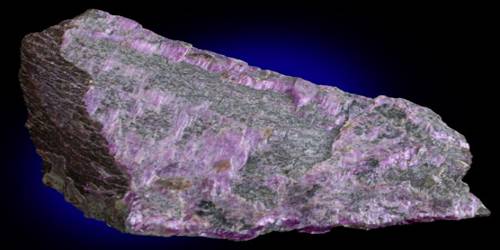Barbertonite is a magnesium chromium carbonate mineral with the formula of [Mg6Cr2(OH)16CO3·4H2O]. It was named after the Barberton district in South Africa, where it first occurred. It forms a dimorphous series with stichtite. This mineral belongs to Manasseite group.
It is polymorphous with the mineral stichtite and, along with stichtite, is an alteration product of chromite in serpentinite. Barbertonite has a close association with stichtite, chromite, and antigorite (Taylor et al., 1973). A study published in 2011 presented evidence that barbertonite is a polytype of stichtite and should be discredited as a mineral species.
General Information
- Category: Carbonate mineral
- Formula: [Mg6Cr2(OH)16CO34H2O]
- Crystal system: Hexagonal
- Crystal class: Dihexagonal dipyramidal (6/mmm).

Properties
The color of barbertonite varies from intense violet to rose-pink, and it appears violet to pale rose-pink in transmitted light. It is flexible in nature but not elastic. It has a greasy feel upon touching.
- Color: Intense violet to rose-pink
- Crystal habit: flattened plates, in fibrous matted masses, and as cross-fiber veinlets
- Cleavage: Perfect on {0001}
- Tenacity: Flexible but not elastic
- Mohs scale hardness: 1 1⁄2-2
- Luster: Waxy, pearly
- Streak: Very pale violet to white
- Diaphaneity: Transparent
- Specific gravity: 2.05 – 2.15
The structure of barbertonite has brucite-like layers alternating with interlayers. Neighboring brucite layers are stacked so that the hydroxyl groups are directly above one another (Taylor et al., 1973). In between brucite layers are interlayers containing CO ions and H2O molecules (Taylor et al., 1973).
Geologic occurrence
Barbertonite occurs as an alteration product of chromite in serpentinite. It occurs as an alteration product of chromite in serpentinite in association with stichtite, chromite, and antigorite. Barbertonite has a distinctly greasy feel to it. It is associated with minerals such as stichtite, chromite, and antigorite.
Barbertonite was first found in the Barberton district in Transvaal, South Africa. It can also be found in the Ag-Pb mine in Dumas, Tasmania, Australia (Anthony et al., 2003).
Information Source:
















